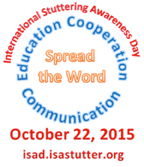
Blog by Voon Pang
Oct. 20, 2015
International Stuttering Awareness Day (ISAD) is Oct. 22 and this year’s theme is “Spread the Word – Education, Cooperation, Communication." It is important for speech language pathologists, children who stutter (and their parents or caregivers), teens and adults who stutter to educate, cooperate and communicate with the general public about stuttering. It is just as important, if not more so, for the general public to understand what stuttering is and what it isn’t.
To summarise, here are 8 ‘fast facts’ about stuttering –
- Stuttering is when the flow of speech is disrupted by repetitions (li-li-like this), prolongations (llllllllike this), or blocks (….like this). These disruptions are accompanied by feelings of ‘loss of control’ by the speaker.
- Stuttering is also referred to as stammering. The term ‘stuttering’ is often used in the United States of America, Canada and Australia, whereas ‘stammering’ is more commonly used in the United Kingdom.
- Stuttering is not caused by being a shy, anxiety and/or nerves. However, having a stutter affects a person’s ability to speak easily and feel in control of their speech, which in turn can affect their ability to communicate confidently. There are many people who stutter who aren’t shy or nervous.
- There is a genetic component to stuttering. Approximately 60% of those who stutter has a family member who stutters as well.
- The brains of people who stutter are different to the brains of people who don’t stutter. Recent neurological research has shown that people who stutter process speech and language slightly differently than those who do not stutter.
- Stuttering is treatable. Early intervention is most effective in the preschool years (before the age of 5 or 6), with speech therapy focusing on facilitating recovery or reducing stuttering to minimal/mild levels. Preschool stuttering therapy involves the parent and the speech-language pathologist working together as a team. School age children, teens and adults benefit from treatment in different ways. Treatment is tailored to the individual’s needs and can focus on building fluency, learning how to stutter in an easier manner or a combination of both to ensure that the speaker is able to ‘take charge’ of stuttering. Thoughts and feelings about stuttering are also addressed to reduce the impact has on an individual’s life.
- Famous people who stutter include Emily Blunt, James Earl Jones, Tiger Woods, Marilyn Monroe, Winston Churchill, King George VI, James Rodríguez, Sam Neill, Carly Simon, Marc Anthony, and many others.
- Simple "advice" or remarks such as “Slow down,” “Think before speaking,” or “Relax” are unhelpful and can de demeaning or frustrating for the person who stutters. Replace the temptation to do this by maintaining natural eye contact and waiting patiently for the person to finish what he/she wants to say.
Stuttering is a complex disorder where there are still many misconceptions about its causes and its treatment. Let’s spread the word about stuttering so that we live in a world that understands.
Useful websites:
The Stuttering Foundation - http://www.stutteringhelp.org/
National Stuttering of Association- http://www.westutter.org/
International Stuttering Awareness Day Online Conference - http://isad.isastutter.org/
America Board of Fluency and Fluency Disorders- http://www.stutteringspecialists.org/
StutterTalk - http://stuttertalk.com/
Voon Pang, Bsc HCS, MNZSTA, CPSP is a speech-language pathologist at the Stuttering & Treatment Research Trust in Auckland, New Zealand. Voon blogs for the Stuttering Foundation and has travelled to the United States, United Kingdom, and Australia to be better equipped at helping those who stutter.






 Podcast
Podcast Sign Up
Sign Up Virtual Learning
Virtual Learning Online CEUs
Online CEUs Streaming Video Library
Streaming Video Library